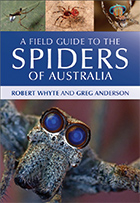An ant mimic with a golden section of the abdomen, apparently mimicking ants. Common in the hills around Brisbane, also found on the coast, and out to Carnarvon. Prefers dry eucalypt forest. Characteristics of this slender ant mimic with long spines on the tarsus include tufts of thick hairs on the tibia of leg I, female with leg like pedipalps, legs III and IV with black femurs, otherwise clear.The species may be Ligonipes lacertosus (Thorell, 1881) or Ligonipes semitectus (Simon, 1900) - these two species may themselves be found to be be conspecific, meaning the same species. Ligo in Latin means to tie, bind or fasten and ipes means Legs, possibly referring to the fringing mass of hairs on legs I which might look like a bandage wound around the tibia, or calf.
- Female from above
- Male sub adult, Sunshine Coast, from above
- Male sub adult, Sunshine Coast, oblique view, facing
- Male sub adult, Sunshine Coast, closeup, facing
- Male sub adult, Sunshine Coast, retreat
- Female, Mcafees Lookout IRM
- Female, Mcafees Lookout IRM
- Female, Mcafees Lookout, epigyne IRM
- Female, Carnarvon
- Drawings, Brisbane Ligonipes, Marek Zabka
- Drawings, L. lacertosus & L. semitectus Marek Zabka
Female from above

Male sub adult, Sunshine Coast, from above

Male sub adult, Sunshine Coast, oblique view, facing

Male sub adult, Sunshine Coast, closeup, facing

Male sub adult, Sunshine Coast, retreat

Female, Mcafees Lookout IRM

Female, Mcafees Lookout IRM

Female, Mcafees Lookout, epigyne IRM

Female, Carnarvon
This specimen differs by having reddish legs I.

Drawings, Brisbane Ligonipes, Marek Zabka

Drawings, L. lacertosus & L. semitectus Marek Zabka


